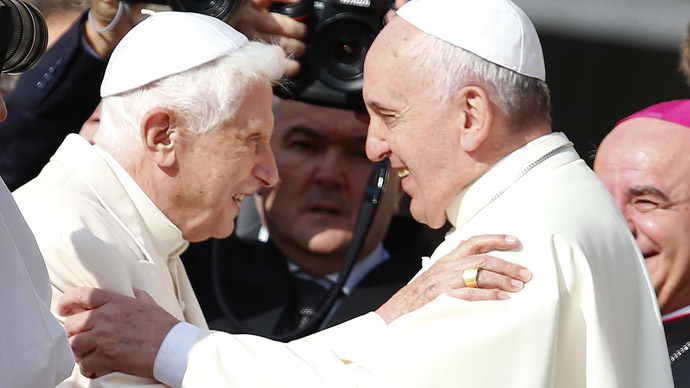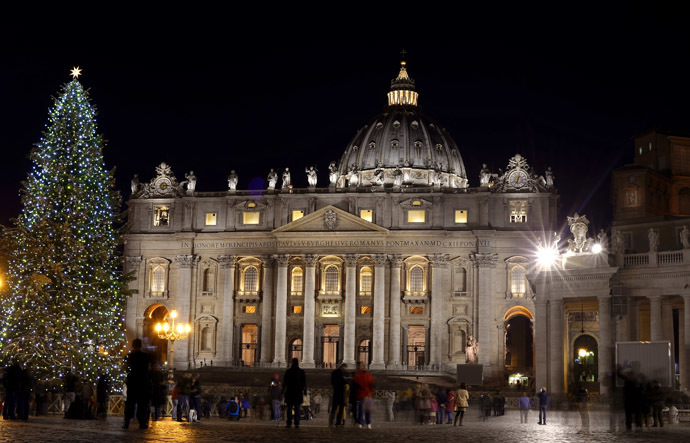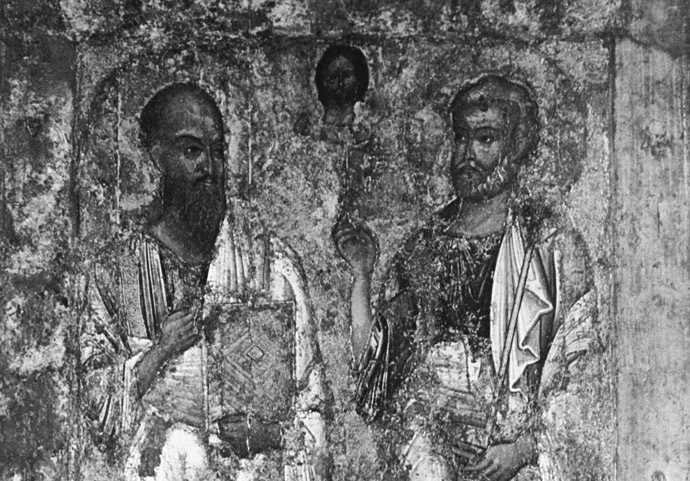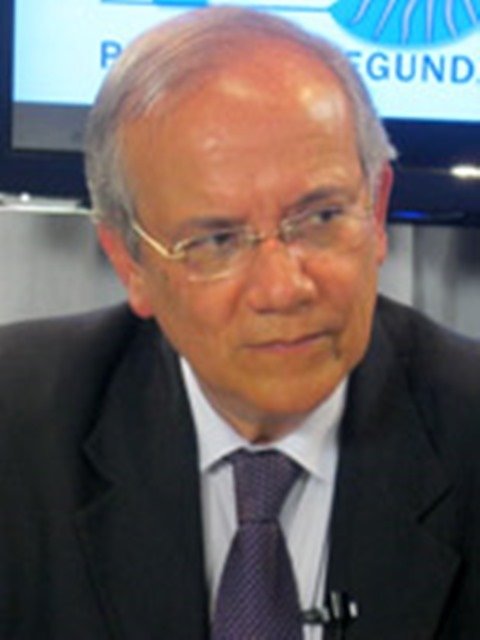A tale of two Popes

The Roman Catholic Church celebrates its second Two-Pope Christmas this week. Is there greater significance behind this than meets the eye?
Is the Vatican actually giving us a sign “in plain sight,” to be understood by "those who have eyes to see and ears to hear"?
The Catholic Church – the main worldly Christian Institution – has undergone deep change, in line with the signs of the times. The key to understanding the Church's 2,000-year success story lies in three factors embedded in its name: it is "Apostolic," (in that its foundations lie in the works and lives of Jesus Christ's key disciples); it is "Catholic" (in Greek – καθολικός – which means universal, or “global” by today’s standards); and last but not least, it is "Roman" (geographically, culturally and geopolitically).
In spite of the hundreds of thousands of early Christians martyred by the Roman Emperors, the Church owes much to Rome. Not only did it fix its HQ smack in the middle of the Eternal City, it also adopted Rome's secular language, Latin, turning it into its own Sacred tongue; blended much of Rome's legal and administrative structure, and adopted many of its symbols, concepts and style.
Thus, the "Pontiff" (bridge) – holds the key to Eternal Salvation and even Jesus’s birthday is celebrated December 25th, the same as Mithras’s: an Iranian god Roman legionnaires brought back with them from the Eastern confines of the Empire. Not to mention that the Cross – the supreme symbol of Martyrdom – was a Roman contraption.
Whatever your opinion, whichever your Faith, the truth is that the Church has weathered time well. Sure today it looks rather weary, tired and gray, but it is nevertheless the West's oldest institution with 2,000 years of uninterrupted continuity, most of it spent in Rome and that’s an awfully long time.
Is there a subtle collective “time-bar” for institutions, measured in such long periods that we do not see it, mainly because our own short lives drive us to think short-term?
Time, time and time
The rules governing Millennia are probably different from our modern, materialistic, short-term concept of time. In fact, the Ancients used three different words when coping with time: “Chronos” described "physical” lineal time; "Kairos" referred to significant points in time when the will of God or the gods was manifested: cosmic destiny milestones, so to speak; and “Aion”: Rome’s god of very long periods of cyclical time, from which we derive the modern word "eon."
For the Church, Chronos seems to be embedded into Kairos which are its significant milestones, which in turn help to "explain" prophecy ("My time is not yet come"); all in turn rolled up into Aion, the cyclical "times of the ages" during which subtle, slow, long-term changes surge and wane in the collective psyche.
In today’s dark crises, have illuminated elements inside the Church understood these mechanisms and are playing them out in the world? Last year, the papacy underwent an almost unprecedented “Kairos” milestone when Pope Benedict XVI (aka Joseph Ratzinger) abdicated to be replaced one moon later by Pope Francis (aka Jorge Mario Bergoglio).
Was this incredible overturning of centuries of orderly papal continuity where new popes were enthroned only after the old pope died, done merely because Benedict felt too old, too tired and too weak to perform his collective worldly and spiritual duties?
Peter and Paul, Church founders
St Peter (Simon Peter, in Latin, Petrus the Rock) died around 64 AD, crucified under Emperor Nero Augustus Caesar. He was one of the original 12 Apostles whom the Church considers as its very first pope, directly ordained by Jesus himself as the "Rock of My Church" (Matthew 16:18). Tradition holds Peter was crucified at the site of the Clementine Chapel and that his bones lie under St Peter's Basilica.

St Paul was a different story. His original Jewish name was Saul; he was younger than Peter and not one of the original 12 followers of Jesus. As a matter of fact, he began by persecuting Jesus' disciples in Jerusalem. Then, as he was on the road to Damascus, the resurrected Jesus appeared to him in a great light striking him blind. But his sight returned three days later and, having "seen the light," Saul changed his name to Paul and began preaching that Jesus of Nazareth was the Messiah and the Son of God.
Paul was a brilliant, prolific intellectual: 14 of the 27 books in the New Testament are traditionally attributed to him. His epistles form the roots of Christian theology, worship and ritual, not just Roman Catholic but Orthodox and Protestant as well.
Paul preached mainly to the heathen and is often referred to as "The Apostle of the Gentiles," whilst Peter kept the flock of converted Jews aligned to the new Creed.
Thus, loyal Peter was the “heart” of the Church, the very rock on which it was built and still stands in Rome; whilst brilliant Paul was the “brains” of the Church, the dogma which still holds to this day (in spite of the Second Vatican Council!).
In very general terms, one could say that Peter and Paul single-handedly founded the worldly and temporal structure of Roman Catholicism, out of which centuries later Protestantism would also spring. It's no wonder that the Church honors their joint solemnities on the same day: June 29 - The Feast of Saints Peter and Paul.
Let's fast forward to the present-day Church. As in a mirror, are we seeing a modern reflection of those two Roman Church Founders who worked together, lived together and almost died together, in the two Pontiffs who today also live and work together and who will in all likelihood also die together in Rome: Pope Francis (the "true" pope) and the retired pope "emeritus" Benedict XVI?

Saint Malachi’s List
Malachi was an 11th Century Irish saint, the Archbishop of Armagh, and the first native-born Irishman to be canonized. Today, he’s best known for an apocalyptic vision he had when journeying to Rome which he hurriedly wrote down, in which he “saw” the 112 popes that would reign after his time until the Last Judgment and Second Coming of Christ.
Malachi’s List was forgotten for 400 years until it was discovered by Benedictine monk Arnold de Wyon. He published it in 1590 as the "Doomsday Prophecy." Many scholars believe this to be an elaborate 16th-century hoax.
Maybe... And yet there is something uncanny about the way the 112 short, cryptic Latin phrases Malachi gave to each of the coming 112 Roman Catholic popes beginning with Pope Celestine II, seem to tally with some aspect – great or small – of the actual bishops who would ascend to the throne of St. Peter in centuries to come.
If it was a hoax, it was definitely a most inspired one.
Add to this another key factor: Timing. Since Malachi drafted his visionary List, we've seen some popes reigning for many long years like Pius IX and John Paul II (31 and 26 years, respectively) and others having sadly short reigns like John Paul I's brief, 33-day tenure.
With such wild variations in the length of popes’ reigns, Malachi’s List could have very well swerved off by literally entire centuries, either ending too soon (centuries ago) or too late (still having centuries to go), and yet…
Here we are in 2014 with the very last pope on Malachi’s List sitting in Rome: a man who just turned 78 and who we should not expect will live many decades more.
So, maybe we shouldn't shrug off old St Malachi too lightly, even if his mysterious list has been abused by New Agers and Zeitgeisters. After all, Malachi was the Archbishop of Armagh, which rings of Armageddon.
Where do we go from here?
Are there deeper collective psychological factors at work even now? Apocalyptic End-Times may very well reflect the awakening of dormant collective Archetypes: the ones Swiss psychoanalyst Carl Jung so aptly studied and spoke about in the last century. But there may also be some self-fulfilling prophecy factors in play.
In 1935, English poet T. S. Eliot wrote a drama called "Murder in the Cathedral," a story about the assassination in his own Canterbury Cathedral of Archbishop Thomas Becket by two knights loyal to English King Henry II Plantagenet, over a political struggle as to who should have the final word on worldly matters: the King sitting in London, or the Pope sitting in Rome.
In one magnificent scene, Becket's loyal monks seek to protect their archbishop by blocking the Cathedral doors as Henry's armed knights draw nigh. Becket, however, orders they remain open, thus seeking – even willing – his own Martyrdom: a veritable "imitation of Christ" in the sense that Prophecy must "be accomplished."
When prophesies hoary with age become embedded into the collective psyche, there may very well be a strong unconscious compulsion to live them out, so to speak, just like in a play or opera. The fascination is in no way diminished by the fact that we know exactly how the play will end, whether it is Murder in the Cathedral, Hamlet, Macbeth, Faust, Wagner’s Ring Cycle... or Malachi's Doomsday List.

Secret of Secrets
Are the deepest recesses of the Vatican, which hide so many secrets, mysteries and intricacies, unwittingly (or not) playing out a Game of Prophecy?
Look at the last four entries of Malachi’s List:
- John Paul I (109 on the List) Malachi called "Of the half moon.” Poor Albino Luciani was enthroned during a half moon in 1978, and found dead in the next half moon, 33 days later.
- John Paul II (110th) he described as "the labours of the sun" (which some construed as the eclipse of the sun): When Karol Wojtyła was born there was a solar eclipse, which happened again during his funeral.
- Joseph Ratzinger (111th) is described as "Glory of the olive": Ratzinger's papal name honors St Benedict of Nursia, founder of the Benedictine Order, of which the Olivetans are one branch.
But suddenly last year Benedict abdicated, generating expectations as to who would be the next and apparently last pope. For No. 112 carries no short and enigmatic description. Rather, Malachi wrote the following ominous words, "Peter the Roman, who will pasture his sheep in many tribulations, and when these things are finished, the city of seven hills [Rome? Jerusalem?] will be destroyed, and the dreadful judge will judge his people. The End."
Pope 112 is Francis, the Argentinean Jorge Bergoglio who thankfully did not choose Peter as his papal name. No pope after the original Peter ever has, a taboo not applied to Paul (six popes carried that name).
If St Paul was the "brains" of the Church, can we see in Benedict XVI his modern counterpart? A brilliant, cold, intellectual, Church doctor, for decades the Prefect of the Congregation of the Doctrine of Faith, aloof from worldly matters?
If St Peter was the simpler, more emotional sturdy "rock" on which Jesus built his Church, is Francis - so beloved by Catholics for his warmth, simplicity, directness and unsophistication, his modern counterpart?
The Church has not had two living popes in Rome for six centuries and although St Paul was never himself pope, gathering "Peter & Paul" together again to join forces in the face of today’s so very challenging times for the Church, its Flock and all toiling folk roaming our bleak planet, might not be a bad idea, albeit filled with dark foreboding.
For these are times of growing "wars and rumors of wars": Ukraine, Syria, Korea, Africa, Iraq, Afghanistan, Egypt, Mali, Somalia, India, Pakistan, Libya, Hong Kong, Sudan, Iran…
Is the Church taking St Malachi more seriously than they care to admit? Has it considered it prudent to "prepare for the worst and hope for the best"?
If based on all the wisdom, information, prophecy, secret truths, damning evidence, and unspeakable proofs hidden away in the deepest recesses and vaults of the Vatican, the Church is preparing for the worst, then maybe we would do well to follow its example.
Political tragedy often arises because vital stories go untold; key information is kept locked away, and the obvious goes unnoticed.
Billions of people would no doubt undergo a collective change of heart if such vital Truths were revealed, if the real culprits were unmasked, if warmongers were righteously punished, and loyal truth seekers were rewarded.
The world needs such a Vital Message.
Maybe it’s time for Rome to come out and really tell it like it is. For if not from Rome, inspired by the spirit of Peter and Paul and the legions of Angels, then from where can we expect even a morsel of Truth to flourish? The world listens with baited breath...
Merry Christmas and Peace to all!
The statements, views and opinions expressed in this column are solely those of the author and do not necessarily represent those of RT.
The statements, views and opinions expressed in this column are solely those of the author and do not necessarily represent those of RT.













